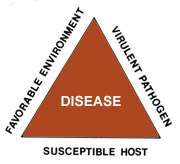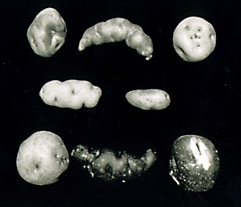from
Plant Diseases: Their Biology and Social Impact.
Lessons from the Potato Famine
From its beginnings in the Irish potato famine, plant pathology has faced a clear set of important problems. Human beings wish to produce food with the greatest efficiency and the least effort. Even in the earliest agriculture, this has meant growing large numbers of individual plants close together in the same area. In addition, the growers prefer that the crop be fairly uniform, meeting standards of taste, color, yield, and even maturation, so that harvesting is simpler. In many cases, genetic uniformity, via vegetative propagation, is highly desirable for the production of particularly good apples or an unusual tulip color. Unfortunately, these horticultural demands create an environment at risk for disease epidemics. An important goal of a plant pathologist is to determine ways to balance the needs of agricultural production with the need for plant protection in a world filled with highly adaptable parasites.
Human beings have probably caused all of the major plant disease epidemics in history, mostly by moving plants and pathogens from their points of origin to every corner of the earth. Plants are most vulnerable to attack by a parasite to which they have never been exposed. Plants and parasites in their place of origin have had millions of years in which to coevolve. The chestnut blight and Dutch elm disease are examples of the devastation caused by introduced pathogens in Europe and North America. Similar problems have arisen when foreign insect pests, such as the Japanese beetle and the gypsy moth, have been introduced. Many Native Americans tragically died of European "childhood" diseases, such as measles and chicken pox, when they were first exposed to those viruses. More recently, astronauts were kept in isolation following the early space explorations to ensure that they had not brought back some pathogen capable of destroying the earth's human population. A similar situation can exist when a plant is taken to a new environment where it is exposed to new parasites, as demonstrated by the severe pear losses from fire blight in North America. Plants and their associated pathogens were carried all over the world without restriction in the mid-1800s. Plant quarantine laws, first passed in the United States in 1912, could not be created until the basic principles of plant pathology were understood. Tremendous plant losses could have been prevented with earlier restrictions. Even today, most people who travel do not understand the continuing threat of foreign pests and pathogens.
The disease triangle demonstrates that three components must be considered in the study of any plant disease--the plant, the pathogen, and the environment. It also warns that significant change in any one of the components should be investigated. The unusual weather conditions of the 1840s certainly contributed to the devastation, but only because P. infestans had arrived from South America. Cool and rainy weather were not such a threat before that.

Fig. 1-18. The disease triangle.
From the tragedy, however, grew a new perspective of the natural world. Disease was no longer a dark and magical force, but a biological activity involving tiny parasites that invaded the plants and caused their decay. The new science of plant pathology involved the study of plants and their pathogens. Crop protection could move from pagan rituals to a scientifically based understanding of the means by which farmers and growers can favor crop growth and discourage infection by parasites. People could consider ways to prevent the fungus from infecting the plant, using chemicals, resistant plants, or environmental management.

Fig. 1-19. Examples of the variety of potato tubers available in the center of origin of the species in the highlands of the Andes.
It soon became clear that every crop is subject to many diseases, each of which is unique. Most of the 100,000-250,000 species of known fungi are incapable of infecting living plants, and even parasitic fungi are usually able to infect only a few closely related species of plants. What is the basis of this specificity, and how are plants able to defend themselves from the multitude of microorganisms in their environment? These questions have not yet been fully answered, but current research continues to work on these fascinating basic questions as well as on the applied problems of crop protection.
The human component of plant pathology was probably never so clear as in Ireland in the Hungry Forties. Yet even today, we remain totally dependent on plants for our food, and, as the human population increases, food production needs increase. At the same time, the amount of arable land decreases each year, as does the number of living species of plants. The centers of origin of the major food crops, which are an important source of the genetic diversity needed for continued plant protection, lie mostly in the areas of the world with the greatest population pressure. An important principle of plant pathology, learned since the potato famine, is that we will never eliminate the parasites of plants, so we must learn to coexist with them and still produce enough food for an ever-growing human population.
The study of the epidemic caused by P. infestans also introduces the important points of a disease cycle. To understand any plant disease, one must know how the pathogen is dispersed to other plants, how it survives unfavorable conditions (such as winter or hot, dry weather), and the effects of environmental conditions at various stages of the life cycle of the parasite. The study of plant diseases requires some knowledge of the biology of the pathogens. Since fungi cause many important plant diseases, the next chapter introduces the fungi and their role as plant pathogens, beginning with P. infestans and some closely related pathogenic fungi.
Introduction
The Arrival of the Potato in Europe
The Potato Plant
The Components of the Epidemic
The Birth of Plant Pathology
Protecting Potatoes from the Blight
Lessons from the Potato Famine
Selected Readings
RETURN TO APSnet FEATURE STORY
